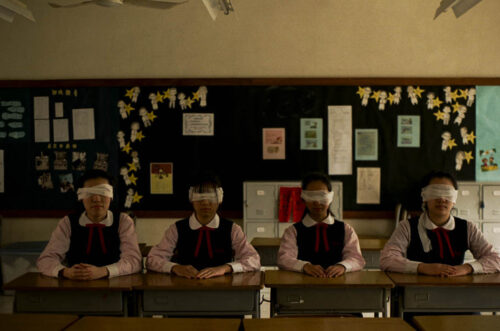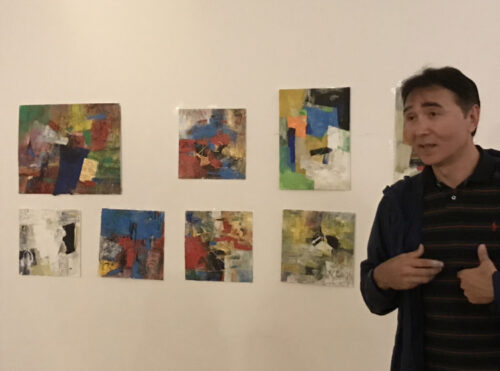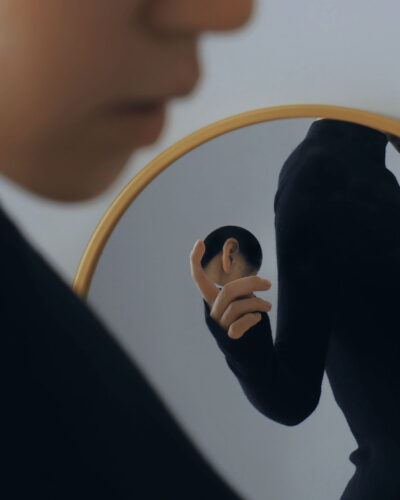This article was originally published on Neocha and is republished with permission.
Constellations and clouds billow across the canvas in dense, inky dreamscapes. The figures in these scenes appear with their eyes closed, perhaps lost in a reverie about their current and past lives. Combining traditional Chinese drawing techniques with a heavy dose of surrealism, these works are the result of Dalian artist Jì Qióng 继琼‘s musings on the past and the present.
As a child, Ji’s parents often took her to Taoist temples. Memories of scroll paintings seen through the haze of incense smoke left a deep impression and instilled in her a fascination with traditional Chinese art. At age five, she began studying ink-wash painting, and the pages of her sketchbook quickly filled with paintings of clouds, rivers, and mountains rendered in gradients of black. “Landscapes like that make my heart soar,” Ji says. “In my work, I’m drawn to wide-open vistas — I feel as though they can break through the bounds of space, as though time’s subtle changes give them an eternal presence.”
Over the course of her studies, Ji tried out several different styles, but ink-wash painting always held a special appeal. “With a brush, you can get endless variations by changing the pressure, and that gives me versatility and freedom.”





Since graduating from the Central Academy of Fine Art in 2017, Ji has created artwork for the music, publishing, and film and television industries. These large, striking, supernatural compositions are far removed from her everyday life, where she seeks inspiration in solitary walks at night or twilight visits to the shore, plugging in her earphones and letting her thoughts roam free. The swirling beauty of her style perhaps owes something to her seaside upbringing: the boundless ocean and the whistling wind have subtly have shaped her art. “I want my works to feel gentle, fanciful,” she says.


Traditional Chinese art stresses the importance of the yijing, or creative principle. For Ji, this comes from the people and things she encounters in her everyday life, transformed by her imagination, as in the case of the tai chi master radiating light against the darkness, or the feast on the cover of Guzz‘s album Walking in a Boundless Dream, with its Southeast Asian motifs. In the winter of 2017, on a walk around Beijing’s Houhai Lake, the sight of her moonlit reflection in the water set her to work on a series depicting people and mythical beings observing each other. As in Lhama Latso, the holy lake in Tibet that’s said to show people’s past, present, and future lives, the images are like reincarnations that reflect the characters’ inner state.


In late 2018, Ji traveled to Tibet to study thangka art, and although she found Lhamo Latso less mystical than expected, she was captivated by the natural and human environment. “It’s a place steeped in mystery, and every time I see the contours of its landscape beneath the stars and moon, I commit it to memory, storing it away to use as inspiration for future creations,” she says. “There are also lots of stunning temples in Tibet with fantastic murals within their walls. My Tibetan friends are all incredibly creative people with a poetic outlook on life. Their ways of thinking have helped broaden my own mind, and that, in turn, has provided new perspectives on my art.”





The mindfulness and attention with which Ji approaches her art is rare. More than a method of painting, what she preserves is a certain artistic charm, an interest in exploring inner realms. From apprenticing with tai chi masters on Wudang Mountain to studying thangka art in Tibet, she believes that safeguarding traditions requires a thorough understanding of them. “History moves at its own pace, and the waning of traditions is unavoidable,” she says. “But our generation bears the responsibility to carry the torch.”
Like this story? Follow Neocha on Facebook and Instagram.
Weibo: ~/jqjqjjq
Instagram: @jjiqiong
Contributor: Pete Zhang
English Translation: David Yen, Allen Young







